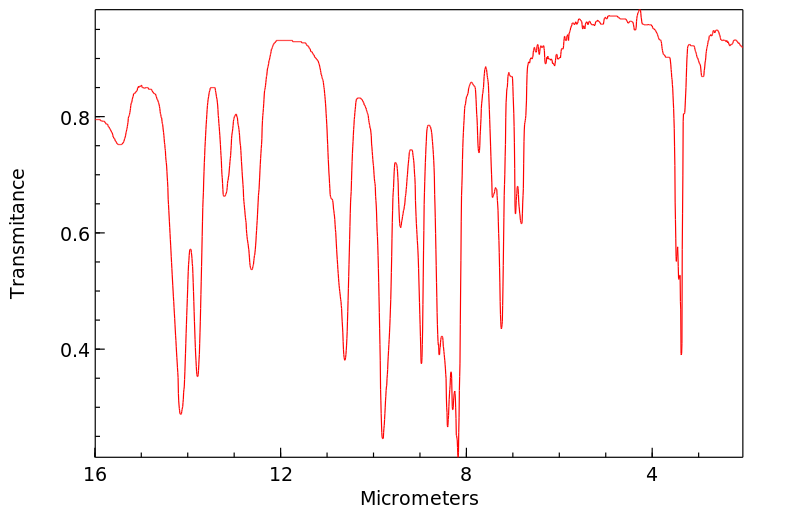N,N,N’,N’-tetraethyl-P-phenyl-phosphonic diamide | 4519-35-1
中文名称
——
中文别名
——
英文名称
N,N,N’,N’-tetraethyl-P-phenyl-phosphonic diamide
英文别名
phenylphosphonic acid bis(N,N-diethylamide);phenylphosphonic acid bis(diethylamide);phenylphosphonic tetraethyldiamide;N,N,N',N'-tetraethyl-P-phenyl-phosphonic diamide;Phosphonic diamide, N,N,N',N'-tetraethyl-P-phenyl-;N-[diethylamino(phenyl)phosphoryl]-N-ethylethanamine
CAS
4519-35-1
化学式
C14H25N2OP
mdl
——
分子量
268.339
InChiKey
KPGVXVMXRHCDQU-UHFFFAOYSA-N
BEILSTEIN
——
EINECS
——
-
物化性质
-
计算性质
-
ADMET
-
安全信息
-
SDS
-
制备方法与用途
-
上下游信息
-
文献信息
-
表征谱图
-
同类化合物
-
相关功能分类
-
相关结构分类
计算性质
-
辛醇/水分配系数(LogP):2.9
-
重原子数:18
-
可旋转键数:7
-
环数:1.0
-
sp3杂化的碳原子比例:0.57
-
拓扑面积:23.6
-
氢给体数:0
-
氢受体数:3
上下游信息
反应信息
-
作为反应物:描述:N,N,N’,N’-tetraethyl-P-phenyl-phosphonic diamide 在 仲丁基锂 、 1,2-二碘乙烷 作用下, 以 四氢呋喃 、 环己烷 为溶剂, 反应 3.0h, 以78%的产率得到N,N,N’,N’-tetraethyl-P-(2-iodophenyl)-phosphonic diamide参考文献:名称:螯合辅助中断的铜(I)催化的叠氮化物–炔烃–叠氮化物多米诺反应:完全取代的5-Triazenyl-1,2,3-三唑的合成摘要:我们描述了通过无配位的多米诺铜(I)催化的叠氮化物-炔烃-叠氮化物螯合带有NP的芳基叠氮化物的方法合成1,4-(二取代)-5-三嗪烯-1,2,3-三唑邻位的O,P═O和SO 3 H基团带有各种乙炔。DFT计算表明,铜螯合是叠氮化物拦截CuAAC中间体的关键因素。催化物质的晶体结构已经通过X射线衍射确定。DOI:10.1021/acs.orglett.0c03838
-
作为产物:参考文献:名称:芳基磷酰胺在桦木还原条件下的反应性摘要:已经在液氨中与碱金属溶液的反应中测试了几类芳基磷酰胺。这种反应的结果取决于起始材料的结构。通常,两个过程——桦木还原或对芳基键的断裂——可以起作用。二芳基次膦酰胺倾向于进行双桦木还原反应以得到双(环己二烯基)次膦酰胺。DOI:10.1002/ejoc.201300344
文献信息
-
Phosphoryl-Related Directing Groups in Rhodium(III) Catalysis: A General Strategy to Diverse P-Containing Frameworks作者:Dongbing Zhao、Corinna Nimphius、Matthew Lindale、Frank GloriusDOI:10.1021/ol402053n日期:2013.9.6Herein, a rhodium(III)-catalyzed oxidative C–H activation of simple arylphosphonates and phosphonamides with subsequent coupling with alkenes (olefination), internal alkynes (hydroarylation and oxidative cyclization), or simple arenes to give access to diverse P-containing functional frameworks is reported.
-
Evaluation of a P,N-ligated iridium(I) catalyst in hydrogen isotope exchange reactions of aryl and heteroaryl compounds作者:Mégane Valero、Annina Burhop、Kristof Jess、Remo Weck、Matthias Tamm、Jens Atzrodt、Volker DerdauDOI:10.1002/jlcr.3595日期:2018.4We have developed a novel and efficient iridium-catalyzed hydrogen isotope exchange reaction method with secondary and tertiary sulfonamides at ambient temperatures. Furthermore N-oxides and phosphonamides have been successfully applied in hydrogen isotope exchange reactions with moderate to excellent deuterium introduction.
-
Hydrogen-Bond-Controlled Formal <i>Meta</i>-Selective C–H Transformations and Regioselective Synthesis of Multisubstituted Aromatic Compounds作者:Jie Wang、Takeru Torigoe、Yoichiro KuninobuDOI:10.1021/acs.orglett.9b00030日期:2019.3.1The meta-selective introduction of functional groups into aromatic substrates was successfully achieved by hydrogen-bond-controlled meta-selective C–H borylation and successive conversion of the boryl group to other functional groups. By this method a wide range of functional groups could be introduced without isolation of the borylated intermediates. The desired meta-functionalized aromatic products
-
A new synthesis of π-electron conjugated phosphonates and phosphonic bis(diethylamides) and their SHG activities作者:Takuji Ogawa、Naoya Usuki、Noboru OnoDOI:10.1039/a709082j日期:——A series of vinylic and arylic phosphonates and phosphonic bis(diethylamides) were prepared by copper promoted substitution of the corresponding bromides. These Ï-electron conjugated phosphonates and phosphonic bis(diethylamides) were investigated to elucidate their optical and second harmonic generation (SHG) properties; it was found that diphenyl 2-(4-dimethylaminophenyl)ethenylphosphonate exhibited strong SHG activity, the efficiency being 13 times greater than that of urea.
-
BIPYRIDYL COMPOUND申请人:JAPAN SCIENCE AND TECHNOLOGY AGENCY公开号:US20170001960A1公开(公告)日:2017-01-05There are provided a compound capable of being a novel ligand allowing regioselective borylation to be performed in the aromatic borylation reaction, and a catalyst using the same compound. There is provided a bipyridyl compound represented by a general formula ( 1 ): (wherein A represents a single bond, a vinylene group or an ethynylene group; X represents an oxygen atom or a sulfur atom; n pieces of R 1 may be the same or different, and R 1 represents a hydrogen atom, a halogen atom, an optionally substituted hydrocarbon group, an optionally substituted alkoxy group, an optionally substituted aryloxy group, an optionally substituted amino group, a cyano group, a nitro group, or an alkoxycarbonyl group, or two adjacent R 1 may form a saturated or unsaturated ring structure optionally containing a hetero atom together with the carbon atoms bonded to the two R 1 ; R 2 represents a hydrogen atom, an optionally substituted hydrocarbon group, an optionally substituted alkoxy group, or an optionally substituted aryloxy group; and n represents a number of 1 to 4 ).
表征谱图
-
氢谱1HNMR
-
质谱MS
-
碳谱13CNMR
-
红外IR
-
拉曼Raman
-
峰位数据
-
峰位匹配
-
表征信息
同类化合物
(βS)-β-氨基-4-(4-羟基苯氧基)-3,5-二碘苯甲丙醇
(S,S)-邻甲苯基-DIPAMP
(S)-(-)-7'-〔4(S)-(苄基)恶唑-2-基]-7-二(3,5-二-叔丁基苯基)膦基-2,2',3,3'-四氢-1,1-螺二氢茚
(S)-盐酸沙丁胺醇
(S)-3-(叔丁基)-4-(2,6-二甲氧基苯基)-2,3-二氢苯并[d][1,3]氧磷杂环戊二烯
(S)-2,2'-双[双(3,5-三氟甲基苯基)膦基]-4,4',6,6'-四甲氧基联苯
(S)-1-[3,5-双(三氟甲基)苯基]-3-[1-(二甲基氨基)-3-甲基丁烷-2-基]硫脲
(R)富马酸托特罗定
(R)-(-)-盐酸尼古地平
(R)-(-)-4,12-双(二苯基膦基)[2.2]对环芳烷(1,5环辛二烯)铑(I)四氟硼酸盐
(R)-(+)-7-双(3,5-二叔丁基苯基)膦基7''-[((6-甲基吡啶-2-基甲基)氨基]-2,2'',3,3''-四氢-1,1''-螺双茚满
(R)-(+)-7-双(3,5-二叔丁基苯基)膦基7''-[(4-叔丁基吡啶-2-基甲基)氨基]-2,2'',3,3''-四氢-1,1''-螺双茚满
(R)-(+)-7-双(3,5-二叔丁基苯基)膦基7''-[(3-甲基吡啶-2-基甲基)氨基]-2,2'',3,3''-四氢-1,1''-螺双茚满
(R)-(+)-4,7-双(3,5-二-叔丁基苯基)膦基-7“-[(吡啶-2-基甲基)氨基]-2,2”,3,3'-四氢1,1'-螺二茚满
(R)-3-(叔丁基)-4-(2,6-二苯氧基苯基)-2,3-二氢苯并[d][1,3]氧杂磷杂环戊烯
(R)-2-[((二苯基膦基)甲基]吡咯烷
(R)-1-[3,5-双(三氟甲基)苯基]-3-[1-(二甲基氨基)-3-甲基丁烷-2-基]硫脲
(N-(4-甲氧基苯基)-N-甲基-3-(1-哌啶基)丙-2-烯酰胺)
(5-溴-2-羟基苯基)-4-氯苯甲酮
(5-溴-2-氯苯基)(4-羟基苯基)甲酮
(5-氧代-3-苯基-2,5-二氢-1,2,3,4-oxatriazol-3-鎓)
(4S,5R)-4-甲基-5-苯基-1,2,3-氧代噻唑烷-2,2-二氧化物-3-羧酸叔丁酯
(4S,4''S)-2,2''-亚环戊基双[4,5-二氢-4-(苯甲基)恶唑]
(4-溴苯基)-[2-氟-4-[6-[甲基(丙-2-烯基)氨基]己氧基]苯基]甲酮
(4-丁氧基苯甲基)三苯基溴化磷
(3aR,8aR)-(-)-4,4,8,8-四(3,5-二甲基苯基)四氢-2,2-二甲基-6-苯基-1,3-二氧戊环[4,5-e]二恶唑磷
(3aR,6aS)-5-氧代六氢环戊基[c]吡咯-2(1H)-羧酸酯
(2Z)-3-[[(4-氯苯基)氨基]-2-氰基丙烯酸乙酯
(2S,3S,5S)-5-(叔丁氧基甲酰氨基)-2-(N-5-噻唑基-甲氧羰基)氨基-1,6-二苯基-3-羟基己烷
(2S,2''S,3S,3''S)-3,3''-二叔丁基-4,4''-双(2,6-二甲氧基苯基)-2,2'',3,3''-四氢-2,2''-联苯并[d][1,3]氧杂磷杂戊环
(2S)-(-)-2-{[[[[3,5-双(氟代甲基)苯基]氨基]硫代甲基]氨基}-N-(二苯基甲基)-N,3,3-三甲基丁酰胺
(2S)-2-[[[[[((1S,2S)-2-氨基环己基]氨基]硫代甲基]氨基]-N-(二苯甲基)-N,3,3-三甲基丁酰胺
(2S)-2-[[[[[[((1R,2R)-2-氨基环己基]氨基]硫代甲基]氨基]-N-(二苯甲基)-N,3,3-三甲基丁酰胺
(2-硝基苯基)磷酸三酰胺
(2,6-二氯苯基)乙酰氯
(2,3-二甲氧基-5-甲基苯基)硼酸
(1S,2S,3S,5S)-5-叠氮基-3-(苯基甲氧基)-2-[(苯基甲氧基)甲基]环戊醇
(1S,2S,3R,5R)-2-(苄氧基)甲基-6-氧杂双环[3.1.0]己-3-醇
(1-(4-氟苯基)环丙基)甲胺盐酸盐
(1-(3-溴苯基)环丁基)甲胺盐酸盐
(1-(2-氯苯基)环丁基)甲胺盐酸盐
(1-(2-氟苯基)环丙基)甲胺盐酸盐
(1-(2,6-二氟苯基)环丙基)甲胺盐酸盐
(-)-去甲基西布曲明
龙蒿油
龙胆酸钠
龙胆酸叔丁酯
龙胆酸
龙胆紫-d6
龙胆紫







